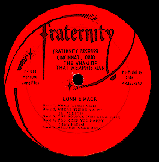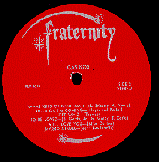
 Fraternity Album Discography
Fraternity Album DiscographyCincinnati, Ohio, is best-known in the record business as the erstwhile home of King Records.
Fraternity was the "other" Cincinnati record company. It was located at 413 Race Street.
Harry Carlson (born December 28, 1904, in Nebraska) was a songwriter and a veteran of dance bands
of the 1930s. When he started Fraternity Records in 1954 (with "silent" partner Dr. Ashton Welsh), it was
to promote popular music and jazz, unlike the giant King label, which specialized in country and blues.
A&R for Fraternity was by Harry and his brother Paul Carlson. Harry had a very successful photography
business, and the Fraternity label was just a sideline.
Most of the early music on Fraternity was largely forgettable pop schmaltz, but Carlson was able to make
a few striking records. His earliest hit was in March, 1956, with songstress Cathy Carr. She had already
had two unsuccessful singles on Fraternity, but when Tin Pan Alley tune "Ivory Tower" became
available, she easily won the chart competition over the r&b-flavored version by Otis Williams (on
Cincinnati-based DeLuxe Records, a division of King) and the mediocre vocal on Dot Records by TV
star Gale Storm. Although the song reached #2, Cathy couldn't maintain the momentum with a followup
single. She signed the next year with Morris Levy's Roulette label out of New York City, and after almost
making the top-40 with the cutesy "First Anniversary," slid into oblivion.
But Harry Carlson's first love was big band music, and if it had taken a rather permanent fall off the
charts years before, Carlson didn't care. He signed bandleader Jimmy Dorsey to his label. Dorsey was in
bad health, but Carlson, a Jimmy Dorsey admirer, wanted to get him one more hit record, and he
accomplished that in January, 1957 with "So Rare," which also reached #2. Dorsey died in June of that
year. The So Rare album was later reissued by the larger Dot Records, as were several other
Fraternity albums.
The earliest Fraternity sides were cut in Chicago, using the band of Dan Belloc, a Chicago-born
musician, also a veteran of the big band era. Although Belloc's lone album on the label [F-1004] did
nothing, he did some interesting records, including some rockabilly sides with Barbara Morgan, aka
Sparkle Moore. Dan was still around the Chicago scene when the rock and roll bands began hitting it big
in the mid-1960s, and he was co-producer of the Buckinghams' #1 hit "Kind of a Drag," which was
recorded for the small U.S.A. label in Chicago.
The 1958-1959 period saw sporadic success for Fraternity. After a couple of minor charters around the
turn of 1958 (a Christmas song by Ruby Wright, another big band vet, and "She's Neat" by rocker Dale
Wright [Dale Riffe]), it was a year before Fraternity had anything resembling a hit. But in December,
1958, Fraternity scored their third #2 record with "The All-American Boy" by Bill Parsons. Parsons was a
singer who had a much more talented friend, Bobby Bare. Bare wrote and recorded the song and gave
the tape to Parsons, who used it to sign with Fraternity. The record was great fun, especially since Elvis
Presley had just gone into the army, but Parsons had trouble following up with the same sound (wonder
why, heh, heh?). Parsons became a "one-hit wonder," while Bare (by then in the army himself) was
destined for the bright lights.
By 1963, it had been a long time since "All American Boy," and most people had forgotten about the
label altogether. But in the summer of 1963, a young guitar player from Indiana by the name of Lonnie
McIntosh had his band in King Records' Cincinnati studio backing another artist. When some studio
time was left, the band recorded an instrumental version of what at the time was a fairly obscure song,
Chuck Berry's "Memphis". The recording was inspired; unlike the slow tempo of Berry's version,
McIntosh rolled out a snappy, danceable, and in retrospect, memorable, version of the song that
Fraternity issued under the name Lonnie Mack. It made #5 on the national charts. "Memphis" was
obscure no more, as other artists such
as Johnny Rivers did the song in Mack's faster tempo and it became a Chuck Berry classic.
Mack was an accomplished guitar player and a passable vocalist. His Fraternity album The Wham of
that Memphis Man not only has guitar pyrotechnics, but his singing is often good (listen to his
remarkable "Where There's a Will There's A Way"). Mack's original Fraternity album is rare in monaural
and even rarer in stereo. Elektra reissued the classic album (in mono) in 1970, with two fine additions,
"Farther on Down the Road" and "Chicken Pickin'." Much of Lonnie Mack's Fraternity catalog was
leased in 1975 to Trip Records, who put out a 2-LP set called The Memphis Sound of Lonnie
Mack which included many sides which had not been on the Wham of that Memphis Man
album. The Trip album has been recently reissued on compact disc as Lonnie on the Move [Ace
CDCHD 352].
After the hit with "Memphis," and the followup "Wham," which made #24, Fraternity sank into obscurity
again. Mack had many other singles over a couple of years, and a few reached the lower reaches of the
charts, but Fraternity couldn't come up with the big hit again. True to form, though, four years later, in
1967, Carlson recorded a nine-member group from Cincinnati called the Casinos, led by Gene Hughes.
They recorded John D. Loudermilk's "Then You Can Tell Me Goodbye," which reached #6. Ironically, it
was the third try for that song (Loudermilk and Johnny Nash had previously released versions several
years earlier to little acclaim). This time, the time and the sound were right, as it was a smash. (Although
the 45 version of the song appeared on their album, Fraternity several years later leased out an alternate
take of the song that has found its way onto many, many oldies collection albums and compact discs.)
About the same time, Fraternity placed a song called "Walk Tall" by the duet of Patti Valentine and Linda
Parrish (calling themselves "2 of Clubs") on the lower reaches of the national charts, but the song was a
top-10 hit in places like Chicago.
During the rest of the 1960s and early 1970s, Fraternity was essentially invisible. In the mid-1970s,
though, Fraternity resurrected itself as a country label. Harry Carlson retired in 1975 and left the helm to
country performer Shad O'Shea. Although not hugely successful on the charts, O'Shea signed several
artists who later made the country charts on different labels. In the end, the Fraternity label long outlived
the more famous King Label, and continued to operate into the 1980s, reinventing itself yet again,
issuing novelty records by Cincinnati disc jockey Gary Burbank. Harry Carlson died on March 16, 1986.
An interesting footnote to the Fraternity Records story is a single by Mike Reid, early in his singing
career [Fraternity 3429, "I'm the Singer"/"Looks Like I'm Lonely Again"]. Mike Reid in the 1970s was an
All- Pro defensive football player for the Cincinnati Bengals. He left football for a career in country music
as a noted writer and performer ("Old Folks," a duet with Ronnie Milsap on RCA, made #2 in 1988).
When Reid's "Walk on Faith" was a #1 country record on Columbia in 1990, he achieved the height that
Fraternity Records came close to many times, but in the end, never reached.
After posting this discography, we got the following letter from Karl Sjödahl:
There are three local Cincinnati "hits" I remember from the '60s which you didn't mention.
"Save
Your Money" by Lonnie Mack was an up-tempo vocal rocker Lonnie recorded after the money he made
from "Memphis" was gone. The song got a lot of airplay on WSAI, the local rock powerhouse. As far as I
know, this version has never been released on an album. An alternate version was on one of his Electra
LPs, but it was missing the power of the original recording. "Hey Dow Dow Dow Dow" by the Dolphins:
Carl Edmondson (who produced the Two of Clubs' "Walk Tall") and others Cincinnati musicians
managed to get to number 6 on WSAI's top 100 records of 1966. This recording has also never seen an
album release. Third, there's "Shamus O'Toole" by Carl Edmondson and the Driving Winds. This
instrumental got a fair amount of airplay on WSAI at the time of its release around 1966. Carl
Edmondson, the Driving Winds and the Two of Clubs were regular performers at a Kentucky club, just
over the bridge from Cincinnati during the mid sixties.
I actually worked with Lonnie Mack in the studio in 1972, after my time in the Army and before I moved
back into television directing in 1973. We recorded four of his tunes at Jewel Recording in Cincinnati,
and a half dozen more at Jewel's Studio B in Hamilton, Ohio. (Lonnie liked the way the small four-track
studio sounded.) Both studios were owned by performer Rusty York, who had a hit himself with
"Sugaree" (released on P.J. 100, Note 10021, and Chess 1730, all in 1959). Nothing has ever happened
with any of these recordings, although re-recordings of the songs have shown up on later Lonnie Mack
albums. I still have a copy of the tapes.
Lonnie and Rusty recorded an album of country flavored instrumentals at Jewel, working with Jewel's
regular studio musicians in 1972. Rusty later told me that the album did fairly well when it was released
in England. I engineered the sessions. Rusty completely mutilated the spelling of my name on the album
(which isn't hard with a name like Sjödahl). Somewhere around here, I've got a copy of that LP as
well.
Around the same time, Harry Carlson was trying to get a hit with a number of obscure bands. Lonnie and
I would take the band's tracks into Jewel Studios, add a guitar or bass part here or there, and attempt to
create a more commercial mix of the tune. We never quite succeeded. None of the records ever did
much, but it was a lot of fun, and I'll never forget working with Lonnie. One of my favorite moments was
Lonnie showing me how to play the guitar "hook" for "Save Your Money".
All the best, Karl.
The first Fraternity label was light blue with black printing. "Fraternity" above the center hole with 3 white
swirling shooting stars. The second label was red with black printing, with "Fraternity" above the center
hole with a single shooting star above the name. The third label was similar to the second, but was
maroon with silver print. There were other colors for the Fraternity labels on 45s and 78s, but we are not
certain these were used for LPs. There was a yellow label with red print, with the Fraternity name in
block print, that was used for 78s, and there was a dark blue label with silver print used for 45s in 1959.
We would appreciate any additions or corrections to this discography. Just send them to us via e-mail. Both Sides Now
Publications is an information web page. We are not a catalog, nor can we provide the records listed
below. We have no association with Fraternity Records. Should you want to contact Fraternity, or should
you be interested in acquiring albums listed in this discography (which are all out of print), we suggest
you see our Frequently Asked Questions page and
follow the instructions found there. This story and discography are copyright 1999, 2003 by Mike
Callahan.
 Back to the Discography Listings Page
Back to the Discography Listings Page  Back to the Both Sides Now Home Page
Back to the Both Sides Now Home Page